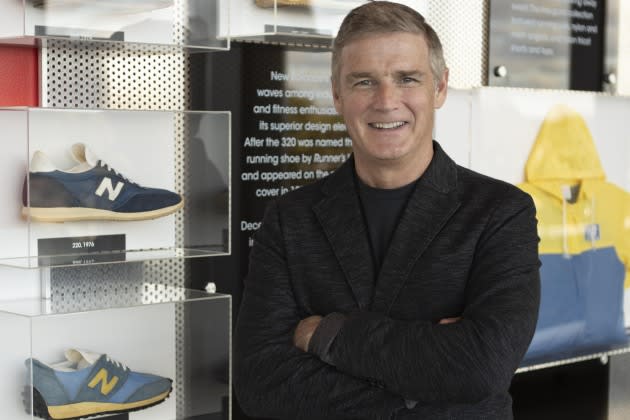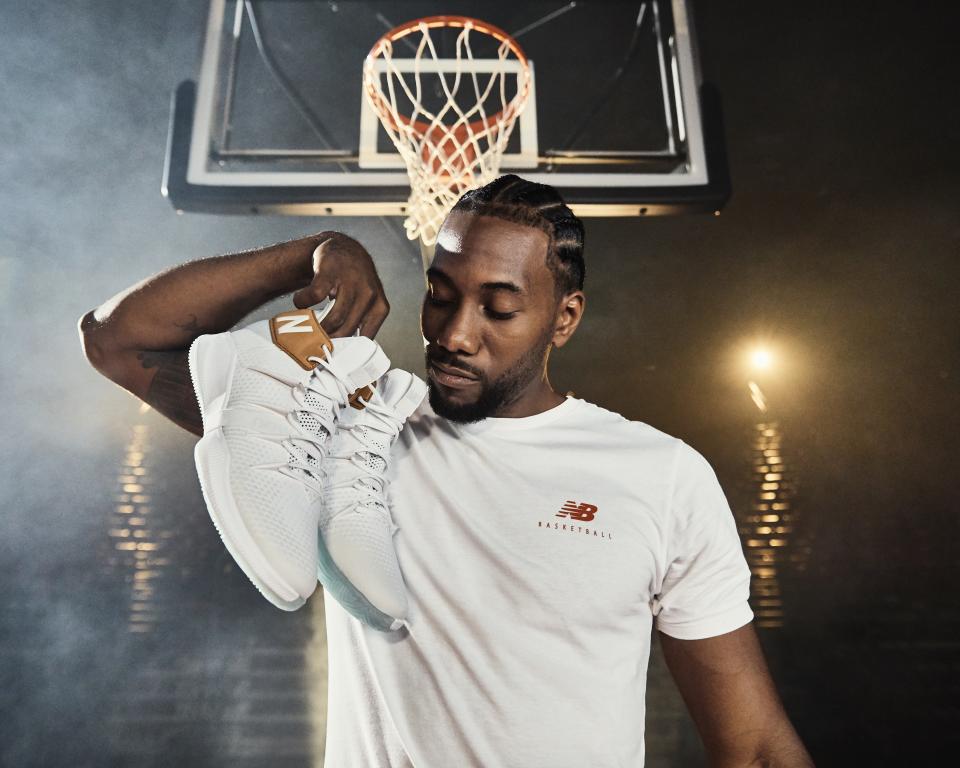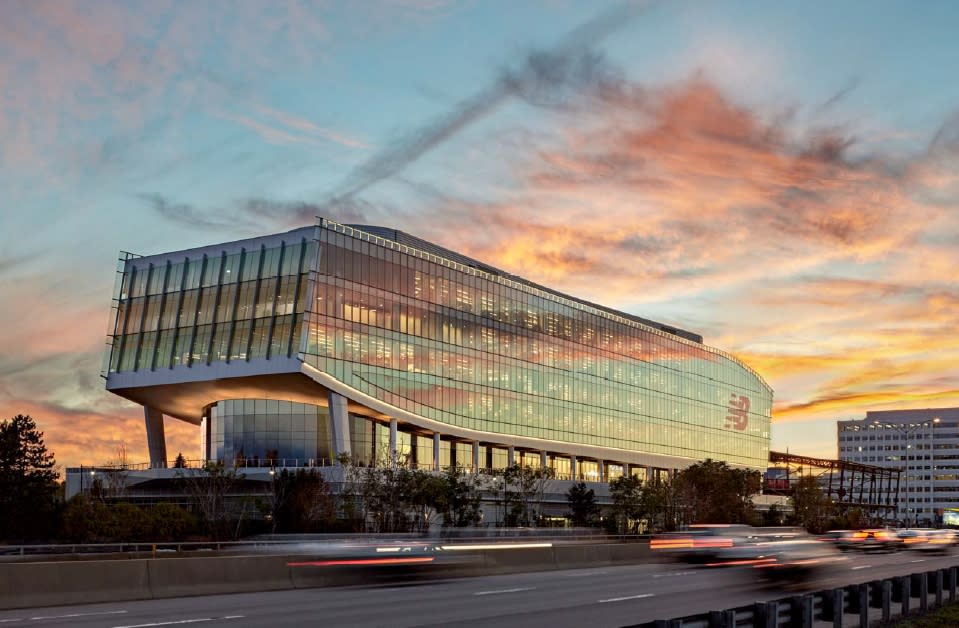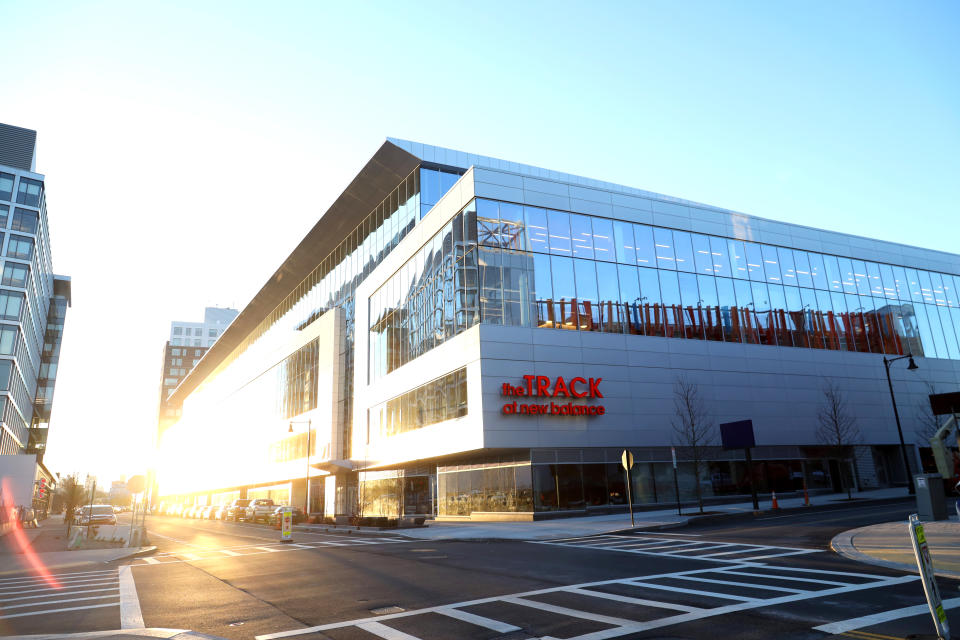CEO Talks: New Balance Chief Joe Preston Hopes to Double Sales to $10 Billion

Joe Preston is a New Balance lifer.
The president and chief executive officer of the sports brand has been with the company for 27 years. Over the course of his career he has served in a variety of roles, including overseeing the Asia-Pacific and international operations and leading its global product and sports marketing initiatives.
More from WWD
He ascended to the top position in 2018 and since then has been working to double the company’s sales — which are expected to hit $5 billion this year — by partnering with up-and-coming athletes and cultural influencers to attract a younger consumer while never losing sight of the company’s roots in performance running.
Here, Preston, who will be honored by the American Apparel & Footwear Association at the 2023 American Image Awards Gala in April, talks about what makes New Balance unique and its growth strategies for the future.
WWD: You’ve been with New Balance for quite some time. You must have seen a lot of changes over the years.
Joe Preston: I’ve been here since 1995 when the company had sales of $150 million with most of it in the U.S. We went on a real growth spurt between 1995 and 2000/2001, in which we grew to about $1 billion in the U.S. Then our next phase of growth was international. By the time we reached late 2008/2009, we were about $2 billion. And then over the next 10 years, we reached $4 billion. Then COVID[-19] hit and all our stores closed everywhere around the globe and we came back to about $3.3 billion.
WWD: Where are you today?
J.P.: In 2021, we jumped back up to $4.3 billion and in 2022, we’ll end up over $5 billion. What’s changed has been the growth and expansion globally. Today we’re about one-third in the U.S. and about two-thirds outside of the U.S.
WWD: How much of your business is footwear versus apparel?
J.P.: We were predominantly only a footwear company for many, many years. But as we began to expand internationally and moved into markets where there were no third-party retailers, we opened New Balance stores and we needed to make sure that we developed our apparel capabilities. So today, apparel accounts for about 20 percent of our overall footprint and we think there’s huge potential there.
WWD: What hasn’t changed?
J.P.: It’s still a family-owned business. Jim and Ann Davis have been operating it since the ‘70s. Jim bought it in 1972. And that is still a core part of our culture and commitment to community.
WWD: You became CEO in 2018. How have you put your mark on the business?
J.P.: We had a strong run from 2012 to 2015. And then we were basically flatlining through ‘18. And so when I became CEO, in October of ‘18, we tried to hit a reset on how we were going to operate, the categories we were going to focus on. And we put together this mantra called: “Control our Destiny.” This was pre-COVID[-19]. And that was all about getting closer to the consumer and controlling the things we could. We’ve long been a really good wholesale partner but when you operate direct-to-consumer, it allows you to get closer to that consumer. You have a direct connection, you can understand where and how you need to pivot. So that was a key point for us. We began this whole digital transformation before COVID[-19] that served us well as we came back into 2020. Basically all of our business was online during those months when all our stores were closed. So we basically rewired the company on the front end, from a design and development standpoint, and then the back end, all the way through our supply chain. And we’re still in the midst of it. We think it’s going to continue to revolutionize how we operate.
WWD: What lessons did you learn during the pandemic?
J.P.: The biggest thing is that it really allowed us to operate more like a global brand. We began a 7:30 a.m. Tuesday morning meeting that we still have today with our functional leaders in our geographic areas all at the table online. And it really allowed us to develop our action plan. We also implemented the “Agile Methodology,” which is usually used just in technology. But we brought it into our leadership team. What we were doing is running 30-, 60- and 90-day sprints in which we would have leaders who had the authority, autonomy and accountability to develop action plans within that time period. And so it allows us to really accomplish a lot and I fundamentally believe that’s the reason why we are in the position we are today.
WWD: You used to rank third behind Nike and Adidas in performance footwear. Where do you stand now?
J.P.: It’s a little hard to delineate between what’s performance footwear and what’s not. But the goal that we set in the 2012 to 2015 time frame was to be the number-three athletic brand. That’s what drove us entering categories other than running. Around 2012, we entered into baseball and signed Dustin Pedroia [formerly of the Boston Red Sox] and a couple of other players. And today about 25 percent of Major League players wear our brand. And if you go to any of the AAU [Amateur Athletic Union organization] games around the country, you can see New Balance all over the field. So that also gave us confidence that we could move beyond what our core had been.

WWD: What came after that?
J.P.: We reentered basketball and signed Kawhi Leonard. And today we have a handful of NBA players that are on our roster of athletes. Then we entered global football, or soccer — first with a team deal, then with two of the arguably top five players in the world with Sadio Mane [who plays for Bayern Munich] and Raheem Sterling [who plays for Chelsea in the U.K.]. So now we have running, basketball, soccer — those are the core categories for us. But running is obviously a big one in our roster of athletes: Sydney McLaughlin for one. She’s the world record holder [in the 400-meter hurdles], and I think that’s allowed us to strengthen our performance credibility as we branch out.
WWD: You’ve got some newer running shoe brands such as Hoka and On that are making big inroads among consumers. How do you keep up with these upstarts who want to take market share from you?
J.P.: I think you have to have teams that are focused in specific areas. For example, our running team is an experienced group. And it’s not about design. It’s about development. It’s about engineering. And it’s also about how you’re servicing the running specialty retailers here in the U.S. and throughout Europe. You’ve got to really stay on each one of those categories, you’ve got to wake up every day and live it. We have teams like that on other categories too, including lifestyle — people who look specifically at what the current trends are and where they’re going. And applying those is a key part of trying to be successful.
WWD: Where have you had the most success as you branch out into other sports?
J.P.: Baseball has been a huge success for us. But with all these other categories that we’ve entered, it is two things. First, it’s the credibility from the performance standpoint, and then it’s the connectivity with the younger consumer. And that has allowed us to sell not just the performance basketball shoes or soccer boots, it has also allowed a crossover to our lifestyle product. In lifestyle, the energy is coming in part from those athletes as well as entertainment ambassadors that we have. The way our marketing and brand teams have brought those stories together along with our product teams which are creating silhouettes and color and materials that are trend-right, is delivering significant momentum for the company.
WWD: Let’s talk a little more about your lifestyle product. You’ve collaborated with a lot of different people including Todd Snyder, Kith, and Stone Island. How do you make that jump without alienating the customer who has been running marathons in your shoes forever?
J.P.: I’m not afraid of us alienating someone who’s been buying our performance running shoes for years. And so long as we’re continuing to deliver the fit, the feel and the performance of those products, we should be able to retain them. The collaborations that we have done brought great energy to the brand. We’re very selective in who we work with and how they are brought to market. And I think that’s an important element. There’s a lot of diligence and execution from our brand and commercial teams to make sure they are brought forward with authenticity. And that’s been quite successful.
WWD: Which ones have been the most successful?
J.P.: We’ve had a relationship with Ronnie [Fieg] of Kith for a long time. And our relationship with Teddy [Santis] of ALD [Aime Leon Dore], as creative director of our Made in USA line, has been excellent. With all our collaborators, we’re trying to work with companies and individuals that we think share our brand values.
WWD: You mentioned Teddy Santis. What does he bring to the table and where do you see the relationship going in the future?
J.P.: He brings out the core authentic values of our brand. I look at his design language and it’s so strong and clear. And he’s brought that to our Made in USA footwear and apparel items. He’s been a great partner.
WWD: Other brands have had problems when their celebrity ambassadors go off the rails. How do you identify who you want to work with and ensure they’re the right fit?
J.P.: We have a sports marketing team and a brand ambassador team, so they are constantly looking at who’s out there and who we think would be a great fit to team up with, whether it’s a specific product collaboration or someone we think would be good to team up with. Our mantra is to be fiercely independent. Sometimes it can be easier for athletes or brand ambassadors just to go with the biggest brands out there. But we think we offer a bespoke approach that allows them to show their personalities. I think many have seen the way we have executed our brand and marketing efforts and that builds upon itself.
WWD: Who are some of your most popular ambassadors today?
J.P.: Jack Harlow, the musician. He was a New Balance fan before we entered into an agreement with him. And he’s been great.
WWD: Anybody else on your wish list?
J.P.: There are a lot, but they wouldn’t let me back in the building if I told you. But the intersection of sport, fashion and music has a lot of energy and we think there’s an opportunity for us to continue to try to find synergies in an authentic way for our brand.

WWD: Who is your customer and what’s the breakdown between men’s and women’s?
J.P.: It’s getting a little hard to answer that question these days because of unisex sizing, but we skew a little more male to female. Performance running is slightly more female to male. If you see young people wearing our brands, some of them are athletes and others just like the fit, the fashion and the trend element. We’ve always had a big tent from a brand perspective, which gives us good opportunity for growth.
WWD: How do sales break down between lifestyle and performance?
J.P.: Pure play lifestyle is definitely bigger than performance, but it really depends on the market. In the U.S., performance is a higher percentage of our overall total revenue than it is in China or Korea.
WWD: How is your business in China, considering the situation over there right now?
J.P.: We have a big presence over there and we’re growing in China, but it’s definitely been curtailed by the situation. When you’re shutting down major cities for days or weeks upon end, it certainly impacts retail in those districts.
WWD: Where do you see apparel going in the future? Do you see it becoming a bigger part of the business?
J.P.: It’s a key part of our growth over the next three to five years. And we have a new head of apparel, Julie Pike. We’re really trying to get everything in order for it to begin acceleration in 2024. And again, with d-to-c being an important part of our overall business in particular markets, growth in apparel is imperative.
WWD: How many stores do you operate and where?
J.P.: We own 475 stores and there are another 3,000 third-party stores. We own and operate stores in the U.S., throughout Western Europe, Japan, Hong Kong and the Pacific.
WWD: Is retail something you’re going to be rolling out or do you think those numbers are going to remain steady?
J.P.: We think it’s an important part of us getting closer to the consumer. But we’re still going to be a wholesaler. We still have strong relationships with some of the biggest retailers around the globe, as well as some of the smallest and most strategic retailers around the globe, specifically run specialty and lifestyle specialty stores. And we think that is also an important part of our bringing our brand to consumers.
WWD: With some of your competitors, their retail stores offer a lot of bells and whistles. Is that something that you feel necessary for your stores as well, or are they more product driven?
J.P.: You have to meet the consumer where they want to shop, how they want to shop and when they want to shop. So everyone that’s coming into one of your stores begins their journey, usually on their phone, on their way or at home. So it’s not just about the in-store experience. It’s about the whole consumer journey. We have a major focus to try and understand that journey by category, because the journey for someone coming in for a performance running product is different than for someone who’s coming in looking for the latest release. And so when they get to the store — or post-purchase — you want to make sure it’s a seamless experience.
WWD: Made in the USA has been a big focus of New Balance. You just announced you’ll be investing $65 million to expand your factory in Skowhegan, Maine. How many factories do you have?
J.P.: We have three in Maine, two in Massachusetts and one in the U.K. And we’re building a distribution center in Tennessee. We opened a second facility in Massachusetts earlier this year. Domestic manufacturing is also about community. The communities where we own and operate these factories benefit at a number of different levels, from the employment of course, but also the giving and involvement that New Balance has for decades.
WWD: Did you benefit from having all of these domestic plants when there was such an issue with supply chain around the world?
J.P.: We’ve had the factory in Lawrence, Massachusetts, since 1982. When all the other brands went overseas, Jim kept his U.S. factories. Of course, they had to shut in March of 2020 but a couple opened back up 10 days later making masks — anything we could do to help the front line at the time. COVID[-19] threw wrenches into any sort of steady-state production, including domestic manufacturing, so it had been a challenge, but it’s operating effectively right now.
WWD: Do you think corporations have a greater responsibility in strengthening American cities post-pandemic?
J.P.: It’s always been part of New Balance. We’ve had four global headquarters, all of them within a quarter mile of where the first one began, just outside of Boston in Brighton. And domestic manufacturing is another example of that. It’s always been an important part of who we are, trying to do good in communities where you live and work.

WWD: You recently opened The Track in your hometown of Boston, a massive multisport facility and sports research lab. Why did you want to invest that kind of energy into a new facility?
J.P.: It was a 10-year project that included the building of new global headquarters. Next door to that was the building of a Bruins practice facility. And then next to that a Celtics practice facility. So both those teams practice in these buildings that are right next to our global headquarters. Across the street, the track opened up this past April and that’s really a great example of community. The track season is 100 days long so the local colleges and high schools will be in there. And the other 250 days of the year, it’s occupied by other activities, whether that’s indoor soccer, basketball or other things that communities come in and participate in. Also, within there, there is a 3,500-person music venue and a 17,000-square-foot [research and development] innovation center for all sports. That’s where our future is going to be created from a product standpoint. This was Jim’s vision of building a New Age headquarters and reenvisioning the area.
WWD: Where do you see New Balance going in the next five years?
J.P.: From a growth standpoint, we laid out a refreshed long-range plan in 2019 — unbeknownst that we’d be facing COVID[-19] a year later — that we refreshed in the middle of 2020, to grow from $7 billion to $10 billion. We didn’t put a date on the $10 billion because we could grow a lot quicker if we wanted to. But it’s not just about total growth, it’s about the quality of that growth. So we have been spending the last three years really trying to strengthen our distribution, introduce new products that are higher-end. And that has helped us be successful. So from a growth standpoint, we believe we can reach $10 billion over the next few years.
WWD: Tell us a little bit more about your management style. Did you have a mentor?
J.P.: Well, I’ve worked with Jim Davis for 27 years — he’s been a great mentor. He’s a real entrepreneur and an eternal optimist. He understands how to operate as a global company and also the importance of being strong in your own community. So that’s had a big influence on me. I think there’s been a lot of carnage with COVID[-19] but the silver lining is the way our team became action-oriented. I fundamentally believe these 30-, 60-, 90-day sprints have been a key part of us trying to operate faster with agility to not just detect consumer trends, but react and respond with products and programs to address it.
WWD: Are there any other Davis family members in the company?
J.P.: Yes, Chris Davis, their son, is our chief marketing officer and he’s doing a great job. And Kassia Davis is president and CEO of PF Flyers and worked for New Balance for a number of years. She also has her own women’s brand [the sustainable fashion brand Kada] that she started from scratch that is completely separate from New Balance.
WWD: New Balance used to own PF Flyers until you sold it to Kassia. What other brands do you own?
J.P.: We also own Warrior, a lacrosse and hockey brand.
WWD: Are you exploring acquiring any other brands?
J.P.: There are always inquiries that come to us to acquire companies. But we believe the opportunity we have with the brand in front of us is significant and exciting. And that’s where we’re focused.